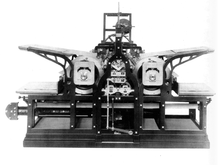User:Morgan Riley/Cylinder press
| This is not a Wikipedia article: It is an individual user's work-in-progress page, and may be incomplete and/or unreliable. For guidance on developing this draft, see Wikipedia:So you made a userspace draft. Find sources: Google (books · news · scholar · free images · WP refs) · FENS · JSTOR · TWL |

A cylinder press or flat-bed cylinder press is one of three general classes of printing presses used in letterpress printing. A cylinder press is one that uses a cylinder to provide the pressure against a flat bed of type. This contrasts with a platen press, which uses a flat platen to apply pressure, and a rotary printing press, in which the type is itself on a cylinder rather than a flat bed (hence the occasional distinction of "flat-bed cylinder press").
The cylinder press was the first type of printing press to be successfully externally powered (via steam engine, line shaft, and later electricity), though some later models were hand-powered. The press was capable of greatly increased production compared to the earlier hand press, in terms of both the number of impressions it could make per hour, and by allowing for larger sheets of paper to be used. This increased production led to increased flourishing of printed material in the mid-19th century. While largely supplanted by rotary presses in large newspaper and publishing houses by the end of the 19th century, cylinder presses remained in common use through the mid-20th century.
Origin
[edit]
Though printmaking presses using cylinders had long been used in engraving, it wasn't until the 19th century that a cylinder was successfully used in letterpress printing.[1]
In the 1790s, English scientist William Nicholson proposed an innovation to the printing press, namely the idea of using a cylinder to provide the needed pressure instead of a platen. Though he obtained a patent on the ideas, they were purely theoretical, and not constructed.[2]
Bryan Donkin and Richard Mackenzie Bacon development of ink rollers to replace the ink balls that were used to hand-ink the type for each impression.
In 1810, Friedrich Koenig, a German-born expatriate in London, worked on and patented a powered platen press, before turning to the idea of a cylinder press.[2] By 1812 an experimental cylinder press had been built and tested.[2]
At that same time in England, the events of Napoleonic Wars had led to an increased demand for newspapers that the existing newspaper establishment was unable to fulfill.[4] Commissioning a two-cylinder press from Koenig, in November 29, 1814, The Times of London became the world's first newspaper printed with a steam-powered press.[2][4] Koenig's machine was capable of producing around 1,100 impressions per hour[5], later improved to 1,800[2] (Wilson. p55) . By contrast, a team of two printers working a hand press could produce around 250 impressions per hour.[6]
The new production capacity revolutionized printing, and enabled the widespread advent of the daily newspaper.
In the 1820s onward, experiments and proposals for faster machines would lead to early forms of the rotary press.[2]
Continued to be used in smaller shops and operations.
Single cylinder
[edit]
Single cylinder presses use a single impression cylinder (which supplies the pressure), though they may use numerous other small cylinders in the form of rollers and grabbers. They are generally classified according to the motion that the cylinder makes with respect to a single printing cycle (one impression).
Single-revolution press
[edit]Alternatively known as a "large cylinder press" or "drum press", a single-revolution cylinder press is one in which the impression cylinder makes a single revolution per impression. It uses a large cylinder to make the impression, most prominent in the United States;
- Napier
- Robert Hoe
Two-revolution press
[edit]Smaller cylinder than the single-revolution press, such that it makes two revolutions per impression.
- David Napier?
Stop cylinder press (Wharfedale)
[edit]
A stop cylinder press (often known in the UK as a "Wharefedale" after the first model popularized there) is one in which the cylinder stops its rotation while the bed returns to its start position. The advantage of the stop-cylinder is that it enabled the paper being fed in to be properly registered on a stationary position (rather than a moving object) before being pulled into the press.
Invented by Frenchman Dutartre in 1852. Wharfedale Became the primary form of .
Two color
[edit]
Two color printer used a single cylinder coupled with two beds (one for each color). The inking systems were located at opposite ends of the machine.
Two-cylinder
[edit]Perfecting machines
[edit]Two-cylinder "Perfecting machines" are named such because of their ability to do "perfecting", that is, printing on both sides of a sheet (the equivalent of duplex printing in modern digital printers).
History: Koenig's Perfecting machine @ Beasley's; Applegate's improvement; (Wilson, p. ?,46); too complicated / working parts compared to the single-cylinder designs, and not worth the maintenance. Superceded by the stop-motion cylinder, which
References
[edit]- ^ Hoe, Robert (1902). A Short History of the Printing Press. New York: R. Hoe. p. 12.
- ^ a b c d e f Southward, John (1897). Progress in Printing and the Graphic Arts During the Victorian Era. London: Simpkin, Marshall, Hamilton, Kent & Co. Ltd. pp. 32–34.
- ^ Blade, William (1891). The Pentateuch of Printing: with a Chapter on Judges. London: Elliot Stock. pp. 85–90.
- ^ a b Grant, James (1871). The Newspaper Press: Its Origin Progress and Present Position. London: Tinsley Brothers. pp. 452–455.
- ^ Encyclopedia Britannica. 1911. p. 352.
- ^ North, Simon Newton Dexter (1884). History and Present Condition of the Newspaper and Periodical Press of the United States. Washington: U.S. Government Printing Office. pp. 100–101.

